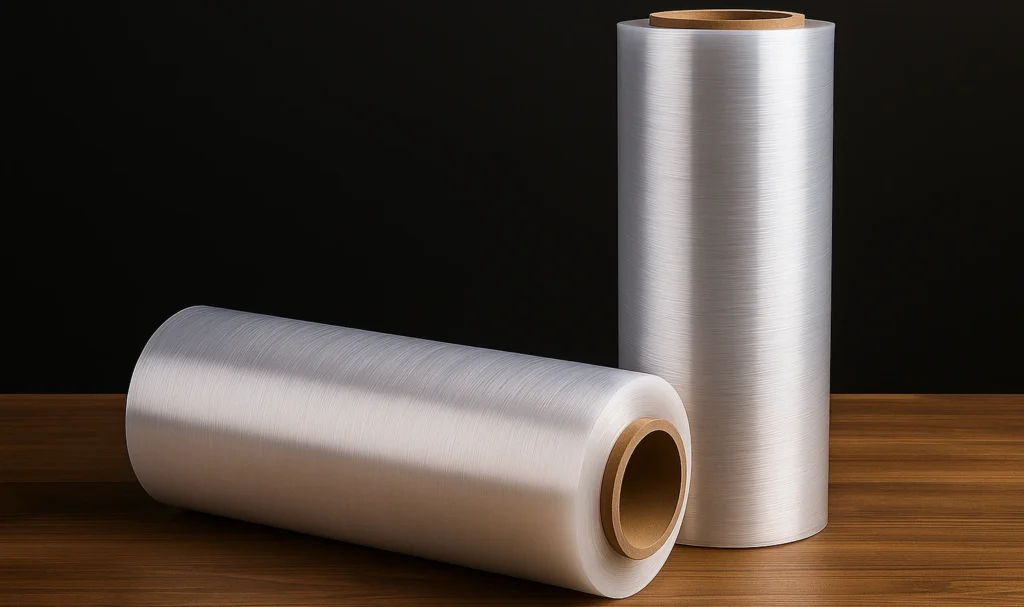During the packaging process with shrink films, there is a high likelihood of errors and problems. The following article will address 10 common issues in the shrink film packaging.

Ballooning
When packaging products, due to the use of direct heat, there is a possibility of air getting trapped under the shrink film, leading to the formation of bubbles beneath it. These bubbles can cause physical damage and tearing.
Usually, to solve this problem, first check the quality of the film and set the heater temperature to an appropriate level. Alternatively, you can use special films called pre-perforated shrink film. These films have thousands of tiny holes that allow air to escape easily during the packaging process.
Crow’s Feet
In this case, usually due to low heater temperature and inadequate heat transfer, the shrink film does not deform sufficiently and causes wrinkles in certain areas of the product, such as corners.
To resolve this issue, it is advisable to adjust the heater temperature to an appropriate level to ensure adequate heat transfer.
Dog Ears
This case is very similar to the previous one. Again, due to low heat, another phenomenon may occur during the packaging process referred to as “dog ears.” A portion of the film at the corners and sharp points may not receive enough heat properly, causing it to stack up and create an excess hanging effect.
As with the previous case, be sure to set the temperature appropriately.
Fish Eyes
These are bubble-like phenomena that appear on the surface of the shrink film and are usually known as “fish eyes.” This issue can be due to the use of low-quality films, which can easily be damaged and do not have sufficient heat resistance.
To solve this problem, it is better to use high-quality and reliable products, increase the tunnel temperature, adjust the air flow in the tunnel, and decrease the passing speed to ensure that the film shrinks properly.
Burn Holes
Burn holes are formed due to excessive heat. To remedy this problem, it is best to lower the tunnel temperature, increase the conveyor speed, use perforated film, and prevent direct contact of the film with hot surfaces.
Weak or Improper Seal
Weak seals arise from incorrect temperature, pressure, sealing time, or the use of thin film, which may lead to packaging opening.
We suggest that to fix this issue, you should accurately set the sealing temperature and also observe the following: contact time and pressure of the seal, cleaning the blades, and using appropriately thick film.
Side Seal Breakage
Seals made of shrink films may lack sufficient strength, resulting in tearing apart. Usually, the reason for this is the accumulation of film on the blade, wear, or improper adjustment of the sealing pressure.
To resolve this issue, pay attention to the following: clean or replace the blades and guides, level and control sealing pressure, and check for appropriate air pressure in the system.
Angel Hair
This occurs when extremely thin strands of melted plastic pull the sealed part of the product away from the shrink-wrapping film. This usually happens when the film does not have enough time to complete sealing and then gets pulled by the wire. Additionally, it can also occur due to conveyor speed, and if the sealer opens quickly, it does not seal properly.
To prevent this, make sure your sealing wire is functioning correctly and check the clamp pressure.
Perforation Hole Tears
In perforated films, if the temperature or air speed is too high, the holes can tear, disrupting the air evacuation process, ultimately causing holes and tears. These holes are usually very small and may not be noticeable at first glance, but if they were larger, attention should be given to: lowering the tunnel temperature and air flow, adjusting the number and size of the holes, and reviewing the perforation mechanisms.
Static Buildup
Static electricity that builds up in polyethylene (PE) films results from the triboelectric effect; that is, when the film roll comes into contact with rolls or parts of the packaging machine, electrons are transferred from one surface to another. This effect is exacerbated in low-humidity environments (such as winter or dry warehouses) since the air has no conductivity, and the charges cannot be discharged.
It is advisable to use anti-static additives in the film formulation to facilitate moisture absorption and surface charge conductivity.
Finally, by reviewing the above points, we can conclude that most problems arising during packaging are due to improper temperature settings, low-quality shrink products, and incorrect timing. It is best to consider the points mentioned before starting the packaging process to save costs and time spent on resolving issues.




No comment